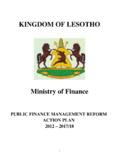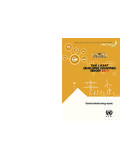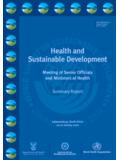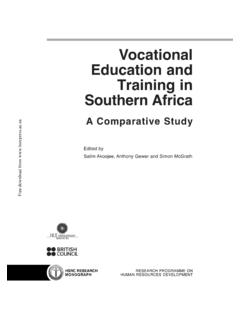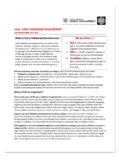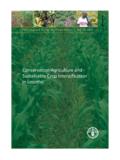Transcription of Chapter 7 15 2 12 edit - treasury.gov.za
1 917 Infrastructure Overview outh Africa s investment in infrastructure gained momentum in the years leading up to the 2010 soccer World Cup, and is set to expand as the foundation of a national growth and development strategy. The country s electricity, water, transport and telecommunications networks are being extended, education and health capacity is being expanded, and human settlements are being built and upgraded to strengthen the fabric of communities. Over the medium-term expenditure framework (MTEF) period, budgeted and approved public-sector projects total billion. As announced in the State of the Nation Address, the Presidential Infrastructure Coordinating Commission will give new impetus to the planning and implementation of major capital projects, described in Chapter 1, raising the level of investment spending and contributing to industrial and regional development.
2 All public-sector infrastructure projects will be subject to rigorous assessment to determine their feasibility. Not all of the trillion of infrastructure projects under consideration (see Table ) will be approved for implementation. Government will choose the most cost-effective projects that provide optimal long-term benefits. Major infrastructure projects can take more than a decade to implement. Meeting the complex challenges of a diverse and geographically dispersed set of capital projects requires long-term planning, detailed analysis, and continual learning and adaptation. Government acknowledges that public-sector capacity to implement projects is presently inadequate, and is taking steps to strengthen planning and implementation capacity at all levels.
3 S Investments in electricity, water, transport, telecommunications and housing All projects will be subject to rigorous assessment, and not all will be funded Coordinating the infrastructure matrix requires improved planning and project assessment 2012 BUDGET REVIEW 92 Reversing a pattern of underinvestment South Africa s critical infrastructure needs are in part the outcome of two decades of underinvestment. As shown in Figure , public infrastructure spending tailed off from the early 1980s. From the mid-1990s, government began to increase capital spending, with a sharp rise after 2003 as prudent management of the economy created the fiscal space for long-term investment. Private-sector capital formation has also increased strongly, rising by 84 per cent between 2002 and 2008.
4 Figure Public and private-sector capital investment, 1962 2010 Source: Reserve Bank The experience of other developing countries shows that capital investment equivalent to about 25 per cent of GDP is generally needed for a substantial rise in per capita income. In recent years, government has sought to accelerate public infrastructure spending, while also encouraging greater private-sector investment. South Africa s public-sector capital investment stood at per cent of GDP in 2010, while investment by private enterprises amounted to per cent of GDP. Table summarises the sectoral breakdown of the estimated trillion worth of large-scale projects currently under consideration or in progress. Of this total, about a quarter are being financed and implemented, and the remaining three-quarters are under assessment.
5 Expanding the range of capital projects under way will depend on thorough feasibility assessments, improved regulatory and oversight processes, and enhanced planning and implementation capacity. This Chapter reviews major developments in key infrastructure sectors. It discusses how government plans to overcome hurdles in managing the infrastructure pipeline and financing capital projects in a sustainable way. 05101520253035 Per centRatio of private investment to GDPR atio of public investment to GDPS harp rise in capital investment began in the mid-1990s In 2010, public-sector capital investment was per cent of GDP and private investment was per cent of GDP A need for thorough assessments of project feasibility Chapter 7: INFRASTRUCTURE 93 Sector review Electricity South Africa s programme to increase electricity generation capacity is well under way.
6 Eskom s two large coal-fired plants Medupi and Kusile are under construction and expected to start operating in 2013 and 2014, with full electricity generation expected by 2017 and 2018 respectively. The Ingula pumped storage scheme is on track to assist with peak capacity supply from 2014. Several mothballed plants have been returned to service and most of their units are operational. Switching on renewable energy capacity Renewable energy features strongly in South Africa s long-term energy plans. The Integrated Resource Plan sets an ambitious target of providing 21 per cent or of generation capacity from renewable sources by 2030. It is envisaged that will be generated from wind, from photovoltaic sources (solar panels) and from concentrated solar power that use mirrors and lenses to concentrate the sun s rays.
7 Other technologies, such as biogas and small hydroelectric installations, are included in the mix. Strengthening renewable energy involves developing local supply chains, diversifying supply and helping meet the environmental goals set out in the National Climate Change Response Paper adopted in 2011. Several other renewable energy projects complement these efforts: Government s renewable energy independent power producer programme aims to procure 3 725MW of renewable energy by 2016. In late 2011, 28 bidders were selected to produce 1 415MW of renewable energy, mostly from wind and solar power. There will be a separate bidding process to encourage smaller producers (<5MW) and to test innovative technologies not included under the main programme. Eskom plans to build a 100MW concentrated solar power plant.
8 Government is exploring the feasibility of a large solar park of between 1 000MW and 5 000MW in the Northern Cape to accommodate independent power producers. Table Mega-projects under consideration, 2012 2020R billion ConceptPre-feasibilityFeasibility Financing Detailed designTenderCons-tructionOngoing prog-rammes1 TotalWater20 32 5 18 74 Transport310 78 17 12 88 8 71 583 Electricity720 268 314 95 103 345 101 1 945 Liquid fuels 211 2 213 Education20 40 125 185 Health
9 50 29 31 110 Telecommunication12 3 15 Human settlement 78 78 Total1 082 268 653 195 109 195 374 328 3 204 % total Ongoing programmes include multiple projects at different stages of development, such as universal access to electricity and school building programme Project stageMedupi and Kusile are under construction and expected to start operating in 2013 and 2014 2012 BUDGET REVIEW 94 Table Major infrastructure projectsProject name/ Implementing agentTotal project cost R billionProject objective and completion target dateStatusEnergyKusile power station (Eskom) 4 800MW coal-fired power station, first unit commissioned by 2014 Under constructionMedupi power station (Eskom) 4 788MW coal-fired power station, first unit commissioned by 2013 Under constructionGrootvlei (Eskom) to service of 1 180MW power station, scheduled completion in 2012 Civil works complete, commissioning in progressKomati (Eskom)
10 To service of 1 000MW power station, scheduled for completion in 2012 Civil works complete, commissioning in progressIngula pump-storage scheme (Eskom) 1 332MW hydroelectric power station to begin operating in 2014 Dam constructed, pipe installation in progressRenewable energy (independent power producers) 725MW of renewable energy procured into national grid by 2016 Tender process under way, 1 415MW of bids in first procurement round confirmedOpen-cycle gas turbine (independent power producers) 1 000MW power plant, scheduled completion in 2021 Tendering process undertakenDistribution backlog (Eskom and municipalities) and new distribution networkOngoing programmeNew transmission lines (Eskom) and new transmission lines over 5 yearsWork in progressTransportPassenger railways (PRASA) a new fleet of rolling stock over 20 yearsProcurement has commencedNational road improvements (SANRAL) improvements, refurbishment and new roadsOngoing programmeRolling stock and locomotives for freight rail (Transnet) rolling stock and locomotives for general freight railProcurement under wayProvincial road improvements (Provincial Department of Roads) , refurbishment and new roads over next 3 yearsWork in progressNgqura container terminal (Transnet) port capacity by 800 000 units, first phase completed in 2012 Port complete, dredging of 2 berths and construction of port rail line in progressWaterLesotho Highlands water project phase II (TCTA) of hydroelectric power and development of water transfer scheme Recent decision to proceed with financing options being developedKomati (TCTA)











